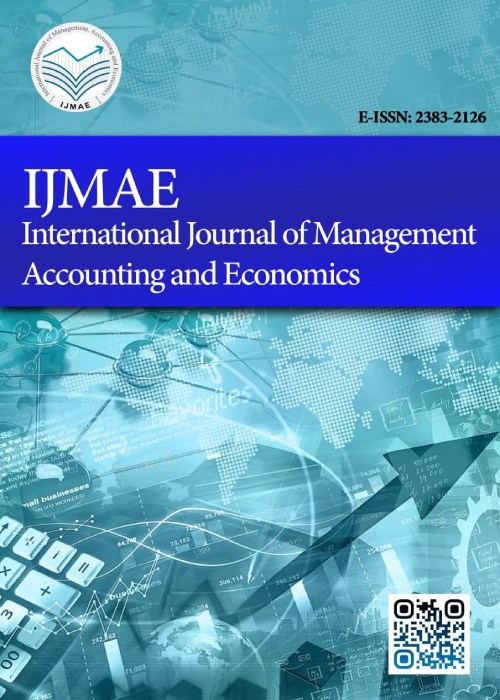فهرست مطالب

International Journal of Management, Accounting and Economics
Volume:9 Issue: 7, Jul 2022
- تاریخ انتشار: 1401/06/23
- تعداد عناوین: 4
-
Pages 413-430This study examined how environmental accounting disclosure influences the market value of listed non financial firms in Nigeria between 2012 and 2020. The research design adopted is the longitudinal design. A total population of one hundred and twelve (112) listed non-financial firms was identified. A purposive sampling was used to generate a sample of seventy-two (72) listed non-financial firms sourced from firms’ annual reports. The dependent variable is the market value measured using earnings per share (EPS). The independent variable is environmental accounting measured by the index of environmental disclosure constructed using a content analysis; eight themes of the Global Reporting Initiatives (GRI). The study employed panel feasible generalized least square regression technique for data analyses. The outcomes revealed that environmental disclosure influence earning per share as well as share price positively and significantly. Hence, this study found robust proof which suggests that environmental disclosure significantly influence market value of listed non-financial firms in Nigeria. The implication is that non-financial firms in Nigeria are yet to show much concern about the physical environment in which they operate; in terms of adherence to the environmental laws and standards, process and product related issues including those related to recycling, packaging, waste, pollution emissions and effluent discharges as well as provision of sustainability and other environmental related information. It recommends that corporate firms should prioritize the inclusion of environmental information in their annual reports as such has potential to bring about higher market value.Keywords: Environmental accounting disclosure, Market Value, earnings per share, share price
-
Pages 431-463The increased knowledge about environment and decline in reservoirs of fossil resources has led the industry to enhance and produce other sustainable fuels by using renewable, which are environmentally acceptable. Biofuel is a kind of fuel derived from biomass resources. Biomass is also the source of fossil fuels that are used today; however, this biomass has been formed over long years. The reduction in fossil fuel resources and the destructive effect of these fuels on the environment have made researchers replace such resources. Therefore, the extant study presented a multi-objective mathematical model for a biofuel sustainable supply chain, by consideration of demand uncertainty. Finally, the research developed the mathematical model considering uncertainty and using Bertsimas and Sim Robustness Approach. According to the proposed model, sustainability objectives were discussed and investigated, including economic, social, and environmental issues. Ultimately, the presented model was confirmed by using the epsilon constrained method (ε constrained method) and the model was validated using the integrated ε constrained-Benders Approach.Keywords: Biofuel, Biomass, Sustainable-Robust, Supply chain
-
Pages 464-481In this article, we provide an in-depth study of the link between global commodity prices and the shocks market. Many Middle East countries are exports dependent and rely heavily on the global price of their primary commodities to make rational economic decisions. It is against this background that this study investigates the level of interdependence between global commodities prices and stock market returns in selected Middle East countries. For this empirical investigation, the two largest stock markets were selected based on market capitalization namely Tehran Stock Exchange (TSE) and Saudi Stock Exchange, TADAWUL (TASI). Specifically, we examined the relationship between global commodities prices and stock market returns and the direction of causality between the variables following Eagle Granger causality procedures. In addition, we determined the effect of global commodities` price movement on stock market returns using the ARDL estimation technique. The results of our analyses show that there is a significant long-run relationship between global commodities prices and stock market returns. Also, there exists a largely bidirectional causal relationship between global commodities prices and stock market returns in the two markets. Furthermore, the results of ARDL estimation reveal that global commodities prices have short-run and long-run effects on stock market returns in the two markets. These findings are robust to a battery of robustness checks. These results support the investor's decision-making process. In addition, the results of this survey are important for policymakers to strengthen the stock market to drive economic growth.Keywords: Commodity, Stock Market, causality, ARDL
-
Pages 482-504The attempt in this study has been to detect the influence of foreign exchange reserves on import demand in Nigeria. With data spanning from 2000 to 2020, we estimated the long-run and short-run import demand function using ‘fully modified ordinary least squares’ and ‘error correction model’ respectively after we established that our variables were integrated of the first order and that cointegration exists. The long-run import demand function pointed out that the effect of foreign exchange reserves on import demand is positive but insignificant but such effect turned negative and significant in the short-run. Import price was also noted to put forth a negative sway on import demand with its effect being significant. Income was observed to wield a positive long-run influence on import demand while the effect of exchange rate was positive and significant in the long-run but became negative and significant in the short-run. By the elasticity coefficients, income elasticity put forth a greater influence on import demand compared to every other variable with the coefficient being greater than unity. It therefore becomes pertinent for actions toward reducing the income coefficient to less than or equal to one to be instituted. It is critical that import demand management be regarded as an aspect of an inclusive stabilization strategy. Imports should be targeted as part of this effort to compensate for shortfalls in domestic production. Furthermore, strategies that reduce government spending or raise taxes (contractionary fiscal policy) could reduce income growth which is a chief driver of import demand.Keywords: Exchange rate, trade balance, J-curve, Marshall-Learner Condition, elasticity


